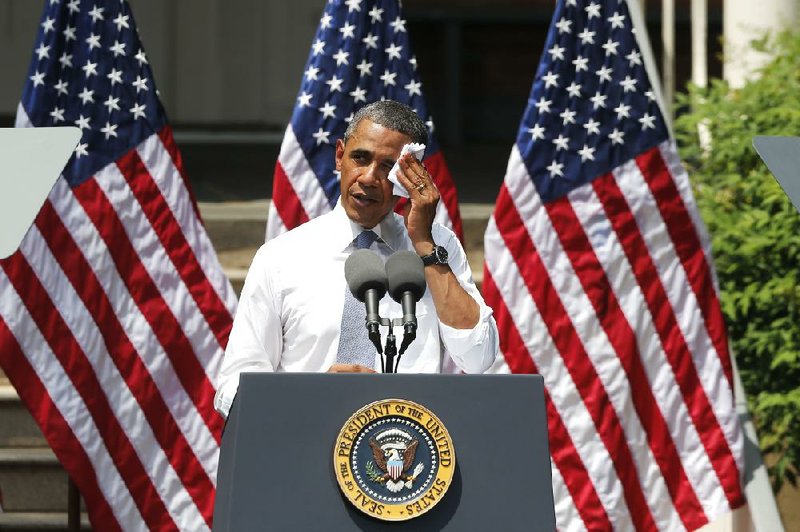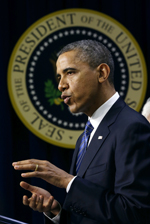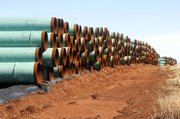WASHINGTON - President Barack Obama declared Tuesday that limiting carbon emissions is in the national interest, setting a standard that will affect almost every sector of the economy, from power plants to the proposed Keystone XL pipeline.
The package of initiatives announced in an address in Washington marks the president’s first detailed plan for confronting what he’s called a central global challenge of the 21st century.
Saying that science had put to rest the question about whether the planet was warming, Obama vowed to use his executive powers to act, arguing that limiting emissions would spur technological advancement and new jobs.
“I don’t have much patience for anyone that denies that this challenge is real,” Obama said in the speech at Georgetown University. “Sticking your head in the sand might make you feel safer, but it’s not going to protect you from the coming storm.”
The centerpiece of the president’s plans, which require no congressional input, are the first-ever limits on carbon emissions from all power plants, a move that has been fought by utilities such as Southern Co. and American Electric Power Co. and coal producers including Peabody Energy Corp.
By focusing on power plants, Obama’s administration is confronting one of the largest contributors to greenhouse-gas emissions. Forty percent of U.S. carbon-dioxide emissions and one-third of all greenhouse gases come from electricity-generating plants, according to the U.S. Energy Information Administration.
There are about 6,597 power plants in the United States, 589 of which are coal fired, according to the Energy Information Administration. Last year, coal plants accounted for 38 percent of electricity produced in the U.S., followed by natural gas and nuclear power, which produced 29 percent and 20percent, respectively.
Actual reductions under Obama’s plan are unlikely to begin until 2018, given the amount of government and legal review required, according to Kevin Kennedy, director of the climate initiative at the World Resources Institute.
“There really is a need to be able to move ahead with a regime of solutions throughout the economy,” he said. “But starting now with power plants is going to be a big first step.”
The president’s plan also includes $8 billion in new loan guarantees for carbon-capture projects, as well as proposals to promote renewable energy development on federal lands, the construction of more climate-resilient infrastructure, and energy-efficiency standards for appliances and federal government buildings.
Obama administration officials wouldn’t put a price on the package.
As the administration rolled out pieces of the plan, the proposals reignited battles with industry groups and Republicans.
“Taking America’s most significant source of electricity offline would have disastrous consequences for our nation’s economy,” Mike Duncan, the president of the American Coalition for Clean Coal Electricity, said in a statement.
Senate Republican leader Mitch McConnell of Kentucky, who represents the nation’s largest coal-producing state after Wyoming and West Virginia, said he planned to tell Obama at a meeting Tuesday that the emissions plan would hurt jobs.
“Declaring a ‘War on Coal’ is tantamount to declaring a ‘War on Jobs,’” McConnell said in a statement. “It’s tantamount to kicking the ladder out from beneath the feet of many Americans struggling in today’s economy.”
The National Republican Senatorial Committee sent statements about Obama’s “radical climate change agenda” to news organizations in states that rely on coal for jobs and energy and where Democratic senators including Mark Pryor of Arkansas, Mary Landrieu of Louisiana and Kay Hagan of North Carolina face re-election in 2014.
“Kay Hagan worked to help elect Barack Obama and is responsible for the liberal policy agenda that will destroy jobs, raise energy costs, and hurt working families in states like North Carolina,” according to one release.
Obama argued that Americans don’t have to choose between economic growth and cutting carbon pollution by pointing to jobs that will be created through the development and use of renewable and more efficient energy technology.
The president’s plan is helped by a recent change in the government’s calculation of the social cost of carbon emissions, a measure that’s used to determine the costs and benefits of climate rules. The U.S. government now assumes it is worth about $36 per ton to avoid emitting carbon, an increase from the $22 per ton price previously used.
“The EPA could generate a rule that is 60 percent more expensive then it would have been prior to the change in the social-cost models and still claim that it is cost beneficial,” said Scott Segal, a lobbyist for coal-fired utility companies. “That’s the kind of back-of-the-envelope accounting that would make Enron smile,” said Segal, referring to then Houston energy company that climbed to No. 7 on the Fortune 500 before spiraling into bankruptcy.
Rules for new power plants proposed by the Environmental Protection Agency, under authority granted by the Clean Air Act, have been indefinitely delayed. Obama plans to put new mandates on the agency, setting a deadline of Sept. 20 for new power plants and the release of a proposal for existing plants by June 2014.
The president pledged more than three years ago to cut U.S. carbon-dioxide emissions 17 percent below 2005 levels by the end of the decade. An administration-backed effort to pass a market-based system to price carbon dioxide failed in the Senate during Obama’s first term, after the White House prioritized votes on the health-care law. The collapse of that bill bitterly disappointed environmentalists, who’d pushed the president to take up the issue sooner.
The president briefly addressed TransCanada Corp.’s Keystone XL pipeline, which is opposed by environmentalists who have been among his biggest political backers. The activists have made the pipeline decision, due from the State Department later this year, a litmus test for Obama on environmental issues.
“Our national interest will be served only if this project does not significantly exacerbate the problem of carbon pollution,” Obama said. “The net effect of the pipeline’s impact on our climate will be absolutely critical to determining whether this project is allowed to go forward.”
The White House has insisted that the State Department is making the decision about whether the pipeline is in the national interest, but Obama made it clear Tuesday that he was instructing the department to approve it only if the project won’t increase overall, net emissions of greenhouse gases.
A State Department report on the pipeline earlier this year acknowledged that development of tar sands in Alberta would create greenhouse gases, but it also made clear that other methods to transport the oil - including rail, trucks and barges - also pose a risk to the environment. For instance, a scenario that would move the oil on trains to mostly existing pipelines would release 8 percent more greenhouse gases such as carbon dioxide than Keystone XL, the report said.
The report also said that even without the pipeline, extraction of oil from the tar sands would likely not be affected.
A top aide to House Speaker John Boehner, R-Ohio, said Obama’s comments indicated that the pipeline should be approved.
“The standard the president set today should lead to speedy approval of the Keystone pipeline,” Boehner spokesman Brendan Buck said. “Based on the lengthy review by the State Department, construction of the pipeline would not have a significant environmental impact. It’s time to sign off on Keystone and put Americans to work.”
TransCanada, the Calgary-based company that has proposed the pipeline, said in a statement Tuesday that it was pleased with Obama’s comments setting out criteria for pipeline approval.
“The almost five-year review of the project has already repeatedly found that these criteria are satisfied,” said Russ Girling, TransCanada’s president and chief executive officer.
“If Keystone XL is not built, it’s clear that the oil will move to market by truck, rail and tanker, which will significantly add to global greenhouse gas emissions to move the product,” Girling said.
The pipeline would carry 800,000 barrels of oil a day across six states to refineries along the Gulf Coast. A southern leg from Cushing, Okla., to ports near Houston, already has been approved and construction is proceeding.
The National Research Council, an arm of the National Academy of Sciences, reported Tuesday that the diluted form of heavy crude from Canadian oil sands fields is no more likely to leak from a pipeline than other forms of oil.
The research council committee found no “evidence of chemical or physical properties of diluted bitumen that are outside the range of other crude oils or any other aspect of its transportation by transmission pipeline that would make diluted bitumen more likely than other crude oils to cause releases.” Information for this article was contributed by Lisa Lerer, Mark Drajem, Roger Runningen and Rebecca Penty of Bloomberg News; by Josh Lederman, Matthew Daly and Rob Gillies of The Associated Press; and by Lenny Bernstein of The Washington Post.
Front Section, Pages 1 on 06/26/2013


